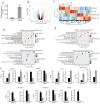SRSF6 regulates alternative splicing of genes involved in DNA damage response and DNA repair in HeLa cells
- PMID: 32901876
- PMCID: PMC7551351
- DOI: 10.3892/or.2020.7750
SRSF6 regulates alternative splicing of genes involved in DNA damage response and DNA repair in HeLa cells
Abstract
Alternative splicing (AS) occurs in nearly all human genes and abnormal AS has a close association with cancer. Serine and arginine‑rich splicing factor 6 (SRSF6), a canonical member of the serine/arginine‑rich protein family, has been characterized as an important regulator of AS. However, the role of SRSF6 in regulating AS in cancers has remained to be fully elucidated. In the present study, the median expression of SRSF6 in tumors was determined to be higher compared with that in matched normal tissues in 13 out of 16 cancer types from The Cancer Genome Atlas. To investigate the biological effects of SRSF6 overexpression, an SRSF6‑overexpression model of HeLa cells was constructed and it was revealed that SRSF6 overexpression resulted in significantly higher apoptosis and lower proliferation compared to control cells. Transcriptome analysis indicated that overexpression of SRSF6 in cancer cells induced large‑scale changes in transcriptional expression levels and AS. Two groups of cervical cancer tumor samples in which SRSF6 was differentially expressed were then selected to analyze potential SRSF6‑regulated AS. It was determined that the pattern of SRSF6‑regulated AS in clinical samples was similar to that in cancer cells and AS genes were enriched in DNA damage response (DDR) pathways, including DNA repair and double‑strand break repair via homologous recombination. Furthermore, AS events regulated by SRSF6 were validated using reverse transcription‑quantitative PCR. The present results highlighted that SRSF6 is able to trigger the activation of DDR pathways via regulation of AS to influence cancer progression. These results markedly expand the current understanding of the mechanisms underlying SRSF6‑mediated gene regulation and suggest the potential use of SRSF6 as a therapeutic target in cancer.
Keywords: SRSF6/SRP55; alternative splicing; cancer; DNA damage response; DNA repair.
Figures







Similar articles
-
Poison cassette exon splicing of SRSF6 regulates nuclear speckle dispersal and the response to hypoxia.Nucleic Acids Res. 2023 Jan 25;51(2):870-890. doi: 10.1093/nar/gkac1225. Nucleic Acids Res. 2023. PMID: 36620874 Free PMC article.
-
SRSF6-regulated alternative splicing that promotes tumour progression offers a therapy target for colorectal cancer.Gut. 2019 Jan;68(1):118-129. doi: 10.1136/gutjnl-2017-314983. Epub 2017 Nov 7. Gut. 2019. PMID: 29114070
-
Angiogenic factor AGGF1 is a general splicing factor regulating angiogenesis and vascular development by alternative splicing of SRSF6.FASEB J. 2025 Mar 15;39(5):e70443. doi: 10.1096/fj.202403156R. FASEB J. 2025. PMID: 40035560
-
Targeting Splicing Factor SRSF6 for Cancer Therapy.Front Cell Dev Biol. 2021 Nov 30;9:780023. doi: 10.3389/fcell.2021.780023. eCollection 2021. Front Cell Dev Biol. 2021. PMID: 34917618 Free PMC article. Review.
-
SRp20: A potential therapeutic target for human tumors.Pathol Res Pract. 2021 Aug;224:153444. doi: 10.1016/j.prp.2021.153444. Epub 2021 Apr 14. Pathol Res Pract. 2021. PMID: 34126370 Review.
Cited by
-
Poison cassette exon splicing of SRSF6 regulates nuclear speckle dispersal and the response to hypoxia.Nucleic Acids Res. 2023 Jan 25;51(2):870-890. doi: 10.1093/nar/gkac1225. Nucleic Acids Res. 2023. PMID: 36620874 Free PMC article.
-
Splicing Genomics Events in Cervical Cancer: Insights for Phenotypic Stratification and Biomarker Potency.Genes (Basel). 2021 Jan 20;12(2):130. doi: 10.3390/genes12020130. Genes (Basel). 2021. PMID: 33498485 Free PMC article. Review.
-
Repression of the expression of proinflammatory genes by mitochondrial transcription factor A is linked to its alternative splicing regulation in human lung epithelial cells.BMC Immunol. 2021 Dec 7;22(1):74. doi: 10.1186/s12865-021-00464-2. BMC Immunol. 2021. PMID: 34876009 Free PMC article.
-
The Catastrophic HPV/HIV Dual Viral Oncogenomics in Concert with Dysregulated Alternative Splicing in Cervical Cancer.Int J Mol Sci. 2021 Sep 18;22(18):10115. doi: 10.3390/ijms221810115. Int J Mol Sci. 2021. PMID: 34576278 Free PMC article. Review.
-
Glucocorticoids regulate the expression of Srsf1 through Hdac4/Foxc1 axis to induce apoptosis of osteoblasts.Commun Biol. 2025 Apr 4;8(1):566. doi: 10.1038/s42003-025-07989-x. Commun Biol. 2025. PMID: 40186004 Free PMC article.
References
-
- Kaczkowski B, Tanaka Y, Kawaji H, Sandelin A, Andersson R, Itoh M, Lassmann T, Hayashizaki Y, Carninci P, Forrest AR, FANTOM5 Consortium Transcriptome analysis of recurrently deregulated genes across multiple cancers identifies new pan-cancer biomarkers. Cancer Res. 2016;76:216–226. doi: 10.1158/0008-5472.CAN-15-0484. - DOI - PubMed
MeSH terms
Substances
LinkOut - more resources
Full Text Sources
Medical
Molecular Biology Databases
Research Materials

